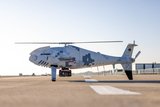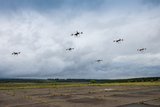TADTE: Taiwan charts independent UAV course
New designs exhibited at the Taipei Aerospace & Defence Technology Exhibition (TADTE) illustrate Taiwan’s developments within the UAV market.
Aircraft showcased by the Chung-Shan Institute of Science & Technology (CSIST) included the Cardinal mini UAV and the Soaring-Kite Trainer UAV, on 11-14 August in Taipei.
A spokesman from the state-run organisation revealed the Republic of China (ROC) Army and Marine Corps have been testing the aircraft, and that a production order has already been placed, although production has not yet started.
Powered by an electric motor, the 2.1kg Cardinal has a 10km range, measures 1m in length, has a 1.5m wingspan, and is hand launched. However, promotional video footage reveals the need for the operator to throw it while running in order to gain the required take-off velocity. A two-man team operates the Cardinal, with one carrying the portable control system and the other the UAV in backpacks.
The platform carries a TV camera for daytime missions, which can be exchanged for an IR system for night- time use, achieved as easily as changing the nosecone. It is for surveillance, reconnaissance and target designation missions, and can be operated manually or autonomously, plus it has a return-home function.
The GCS is the same as that used for the much larger Chung Shyang UAV, allowing easy interoperability for personnel. The Chung Shyang is already in production, with ‘at least ten airframes’ operating within the ROC Army, and it recently reached the significant milestone of 1,000 flying hours.
The low-cost Soaring-Kite Trainer UAV, with 2.8m wingspan, acts as a training platform before external pilots move up to the Chung Shyang.
TADTE was also used as a forum to promote new concepts and technologies. One example of this is the Gaui rotary-winged UAV. Several prototypes exist, and it performed its maiden flight last month. A representative from the Information & Communication Research Division of CSIST claimed the first flight was a success.
The 20kg system can carry a 15kg payload inside the fuselage, has a one-hour endurance and is powered by a 100cc petrol engine. It has military and border surveillance applications, as well as civilian utilisation for environmental mapping and disaster assessment. The latter is important since Taiwan is regularly subject to disasters such as typhoons and floods.
CSIST also showed two concept models of ‘new-generation’ designs the organisation is looking into. One was a Predator lookalike while the other was a UCAV. Detailed design work has not begun, nor do the designs even have names assigned, but they do express Taiwan’s desire to operate MALE and armed UAVs in the future.
CSIST confirmed Taiwan is not looking for military off-the-shelf UAV designs or technology from overseas, because aircraft can be developed and produced ‘more cheaply’ in Taiwan. The design institute disclosed it is also working on a micro UAV with a six-inch wingspan, but staff were unforthcoming about further details.
More from Uncrewed Vehicles
-
![Ready for the race: Air separation drone swarms vs. air defence systems]()
Ready for the race: Air separation drone swarms vs. air defence systems
As the dynamics of aerial combat rapidly evolve, Chinese scientists have engineered a sophisticated air separation drone model that can fragment into up to six drones, each capable of executing distinct battlefield roles and challenging the efficacy of current anti-drone defences such as the UK’s Dragonfire laser system.
-
![Israel’s MALE UAVs ‘must adapt’ to Iranian-made air defences]()
Israel’s MALE UAVs ‘must adapt’ to Iranian-made air defences
Advancements in air defence technologies have begun to reshape aerial combat dynamics in the Middle East, as illustrated by recent events involving the Israeli Air Force and Hezbollah.
-
![Hundreds more UAS sent to Ukraine forces with thousands more on the way]()
Hundreds more UAS sent to Ukraine forces with thousands more on the way
Both sides of the Russia-Ukraine war have been using UAS for effective low-cost attacks, as well as impactful web and social media footage. Thousands more have now been committed to Ukrainian forces.
-
![AI and software companies selected for US Army Robotic Combat Vehicle subsystems]()
AI and software companies selected for US Army Robotic Combat Vehicle subsystems
The US Army has intentions to develop light, medium and heavy variants of the Robotic Combat Vehicle (RCV) as part of the branche’s Next Generation Combat Vehicle family.
-
![DroneShield to improve software of DroneSentry-X C-UAS system under new contract]()
DroneShield to improve software of DroneSentry-X C-UAS system under new contract
DroneSentry-X, a cross-vehicle compatible, automated 360° C-UAS detect and defeat device, can offer 360° awareness and protection using integrated sensors. According to its manufacturer, it is suitable for mobile operations, on-site surveillance and on-the-move missions.
-
![Ukraine takes delivery of new indigenous C-UAS systems]()
Ukraine takes delivery of new indigenous C-UAS systems
Funded by the country’s former president, the new C-UAS systems will be sent to the frontline where they have already been tested against Russian invading forces.


























